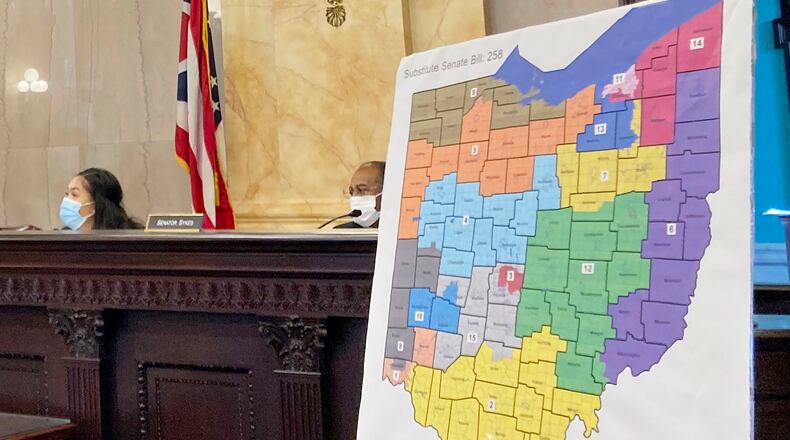The proposed amendment would create the 15-member Ohio Citizens Redistricting Commission, consisting of five democrats, five republicans and five independent board members, with restrictions on current or recent officeholders, large political donors, lobbyists and other political insiders from sitting on the board.
This body would replace the Ohio Redistricting Commission, which currently comprises three statewide officeholders and four state lawmakers.
O’Connor has said the current system gives politicians too much control over the map-making process and lends itself to gerrymandering too easily.
“When politicians draw biased, often ridiculously-shaped districts to favor their own political interests, that’s gerrymandering,” O’Connor said in a recent news release for Citizens Not Politicians. “Ohio is one of the country’s most gerrymandered states, and even today, is operating under maps deemed unconstitutional by the Ohio Supreme Court. This proposal would end gerrymandering by empowering citizens, not politicians, to draw fair districts using an open and independent process.”
Ohio’s legislative maps have been a point of unresolved contention since the state was spurred to create new maps with 2020 census data. The current maps were deemed unconstitutionally gerrymandered by O’Connor’s Ohio Supreme Court. A federal court order allowed the current maps to be used in order to run state elections, but further redistricting is expected in the coming months to settle the map debate for now.
The campaign hoped to get an amendment on the ballot for the November 2024 general election, but that goal faces more uncertainty with Wednesday’s decision. Had it been approved by Yost, the campaign’s proposal would have been assessed by the Secretary of State-led Ohio Ballot Board, which is tasked with ensuring that proposals contain only one constitutional amendment. After that, it would be able to begin circulating its petitions and collecting signatures to get on the ballot.
As with all citizen-initiated amendment proposals, Citizens Not Politicians had to create its proposal, provide a brief summary, and collect 1,000 signatures in order to get it considered by the attorney general.
“The attorney general’s role in the petition process is to determine whether the language submitted both fairly and truthfully summarizes the proposed statute or constitutional amendment. The summary language failed to meet this requirement,” a news release from Yost’s office said.
In his rejection letter, Yost outlined nine instances of “omissions and misstatements that, as a whole, would mislead a potential signer as to the actual scope and effect of the proposed amendment.”
Chris Davey, spokesperson for Citizens Not Politicians, issued a news release vowing that the campaign will try again.
“We believe our summary was accurate. But we will review the Attorney General’s guidance, will make necessary adjustments, and will collect new signatures with our broad, statewide, nonpartisan coalition of partners to refile as soon as possible because it’s time for citizens and not politicians to draw Ohio’s legislative maps,” Davey said.
Critics say the proposed setup could be easily manipulated, including by groups like the well-funded National Democratic Redistricting Commission, which is led by a former U.S. attorney general.
“So-called citizen led commissions are anything but that, they are proxy votes and puppets of partisan special interest groups like Eric Holder’s NDRC,” said John Fortney, a spokesman for state Senate President Matt Huffman, a Republican who helped draw maps last year.
How we got here
Voters overwhelmingly supported creation of Ohio’s existing system in two votes: One in 2015 that created the bipartisan Ohio Redistricting Commission to draw Statehouse maps, and another in 2018 that extended the commission’s role to drawing U.S. House districts and added a role for the Ohio General Assembly.
A crucial flaw of the current system is it lacks any enforcement mechanism for requiring mapmakers to fix proposals rejected by the courts.
Under current rules, if both political parties approve new boundaries, the maps will be in place for a decade. Support by just one party results in a four-year map.
But seeming incentives for bipartisan compromise failed. Democrats didn’t cast a single vote for any of the final maps, which were all Republican-drawn, and the GOP-controlled commission defied repeated instructions from the state Supreme Court to more closely align district boundaries with Ohio’s political composition.
Republican legislative leaders appealed an Ohio Supreme Court decision regarding the congressional map to the U.S. Supreme Court, which has directed the Ohio court to reassess the map. That was after the national high court’s June ruling in a North Carolina case rejecting an expansive version of the so-called independent state legislature theory, which holds that lawmaking bodies have absolute power in setting the rules of federal elections and cannot be overruled by state courts.
Republican Gov. Mike DeWine has yet to reconvene the current commission, as required, to fix the state’s Ohio House and Ohio Senate maps. A member of the Ohio Redistricting Commission as governor, DeWine has said he doesn’t believe politicians should have the job but has stopped short of endorsing the ballot amendment.
“The system we have today doesn’t work very well,” he told reporters this week. “No great revelation to anyone in this room who watched this unfold. It just didn’t work very well.”
The Associated Press contributed to this report.
About the Author

